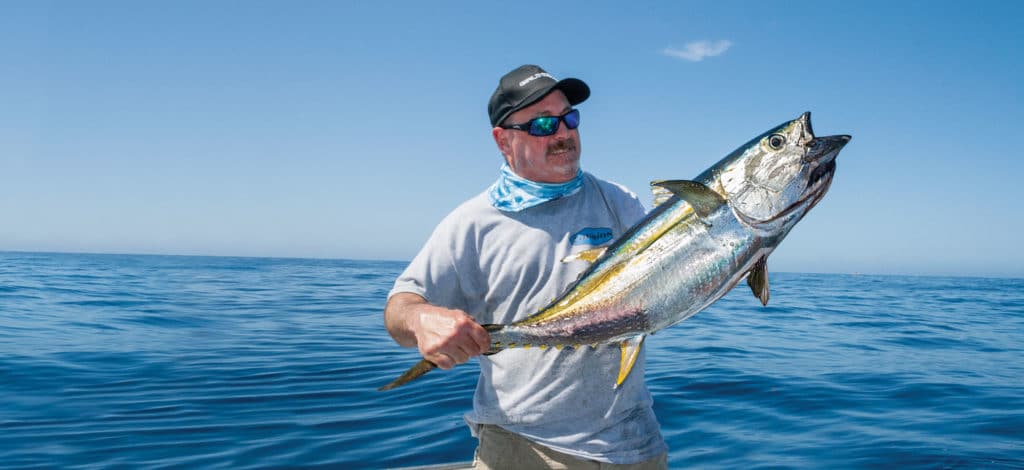
A small group of sooty shearwaters bobbed about on a glassy ocean. As we idled closer, the birds eyed us suspiciously, then lit out. No sooner had the shearwaters taken off than a school of yellowfin tuna erupted in their place. Ron Ballanti and I cast live sardines to the foaming school and hooked up immediately, and within 15 minutes, a pair of gleaming 30-pound yellowfins decorated the deck.For many Southern California anglers, yellowfin tuna represent the most prized of offshore targets. Some fish range upward to 80 pounds, but most yellowfins here run 15 to 40 pounds.Yellowfins typically arrive within striking range of SoCal ports in late July and early August. Migrating from southern latitudes, the first fish are often caught off northern Baja California by anglers venturing 50 to 60 miles below the border. As summer wears on and ocean temperatures climb, yellowfin tuna continue northward into U.S. waters, as far as the Channel Islands, 150 miles north of the border.Yet these fish aren’t always easy to find, and sometimes they don’t want to bite, especially when they key on small anchovies or schools of fry. In addition, yellowfins remain consistently inconsistent in their feeding habits. What produces one day might not work the next, making these swift offshore predators moving targets in more ways than one. The key to success lies in adaptation: changing from one technique to another until you find the one that works. Here are some tricks that have worked in recent years.
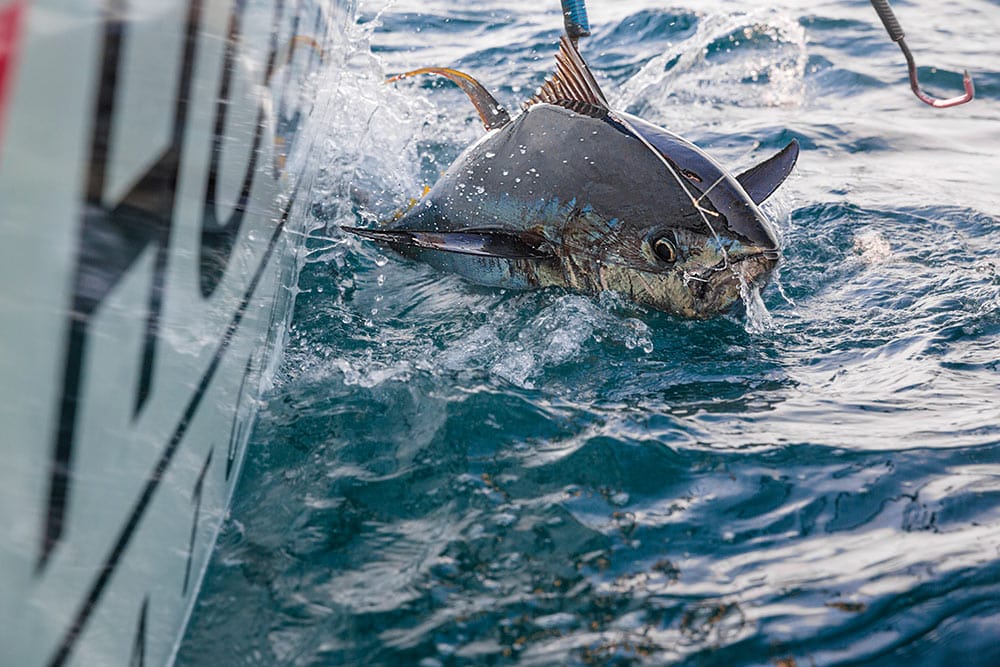
Locating Fish
Figuring out where to fish is easier these days, thanks to the internet. Check online fishing forums, where anglers post reports, a day or two before your trip to find the hottest areas, which are usually seamounts and high spots. During the first two weeks of September last year, schools of yellowfins concentrated around a high spot known as the 425, in Mexican waters, 26 miles below San Diego. That information appeared online.
Many anglers buddy-boat to pinpoint tuna. Typically, two to three boats spread out over a 5- to 10-mile area stay in touch via VHF or satellite phone to report signs of life or actual catches. If one of the boats finds fish, the others join the action.
Trolling cedar plugs, feathers and diving lures such as a Halco Max130 or Rapala Magnum X-Rap 30 represents the time-tested manner of searching for tuna. Most anglers troll a spread of lures at around 7 knots in hopes of a “jig stop,” when a school of tuna follows a hooked fish close to the boat. The crew chums with live bait (commonly Pacific sardines) to keep the school around while other anglers cast live baits to hook more tuna. It’s a technique that results in spectacular action, sometimes filling the boat in an hourlong stop. Once the fish are chummed into a frenzy, artificial lures, such as poppers, and small spoons, such as Coltsnipers, often prove effective, making tuna fishing even more fun.
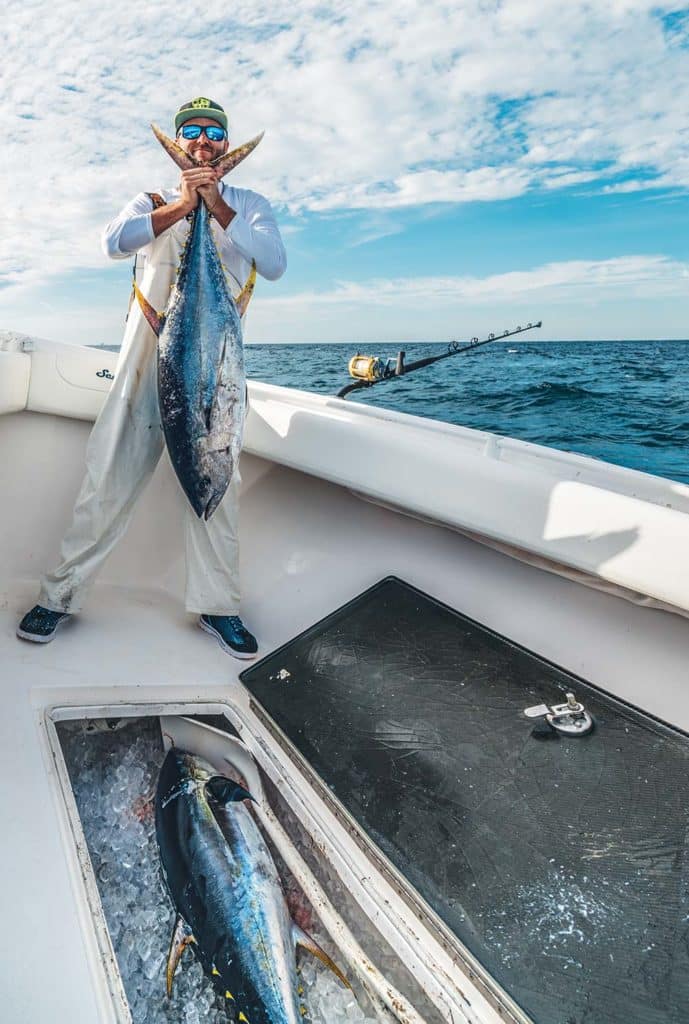
Bird Brain
Study the birds — they know the whereabouts of tuna before you do.
Sometimes our feathered friends provide an obvious tipoff. Wheeling and diving terns are hard to ignore, a sure sign that fish are driving bait to the surface. When you see this, get a live bait or lure under the birds as soon as possible.
Sometimes birds provide more subtle clues. A group of shearwaters sitting on the water might not be a classic indicator, but it may well mean that there are yellowfins feeding in the depths. The shearwaters wait for the tuna to drive the bait to the surface.
Once the shearwaters fly off, the tuna often rise to the surface. One theory holds that bait stays deep as long as the shearwaters sit on the surface in anticipation of an easy meal.
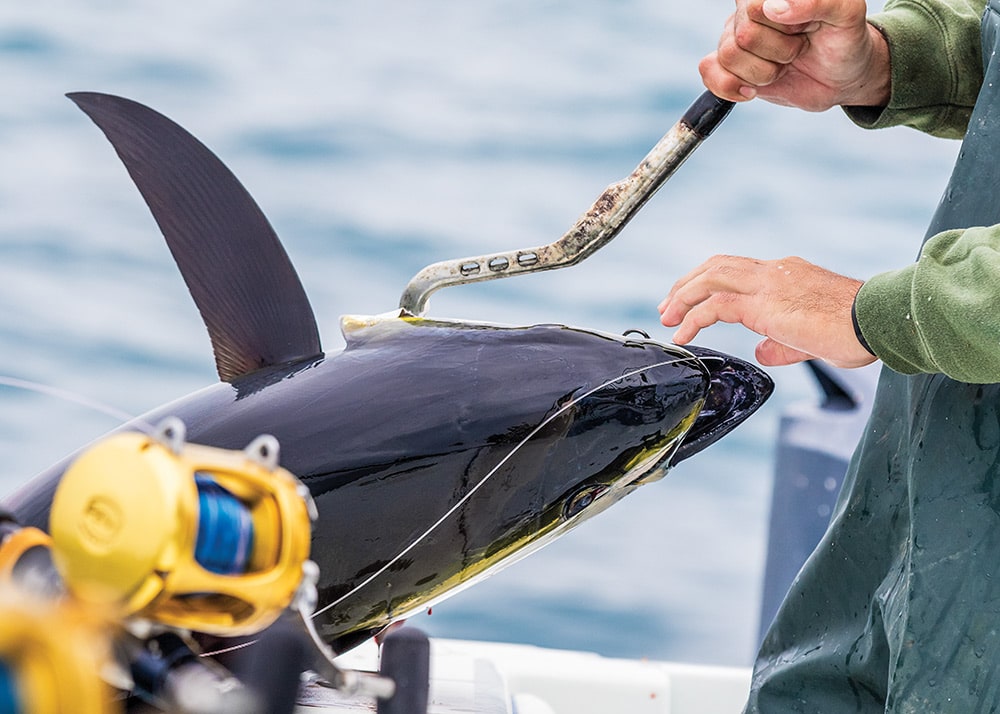
Flipper Cameo
Schools of yellowfin tuna share a symbiotic relationship with pods of dolphins. In a behavior not clearly understood, the two travel together, the tuna swimming below large, swiftly moving pods. No one knows if it’s the yellowfins leading the dolphin or vice versa.
Not all pods of dolphins are accompanied by yellowfins. Other times, the primary bite shifts to chasing what local anglers call “porpoise schools.” One sign that gives away the presence of yellowfins is a flock of noisy terns leading the pod. This gives rise to the notion that the tuna are out ahead of the pods and the terns can spy them from above.
While trolling lures in front of or parallel to the pods produces strikes, a more effective method is to anticipate the course of the pod, maneuver out ahead of it, then shut down and cast live sardines. It’s a run-and-gun fishery, and the dolphins move fast. Once you hook a tuna in this manner, the school sometimes comes to the boat, and if you have enough live bait to chum, you can hold the school and hook more fish.
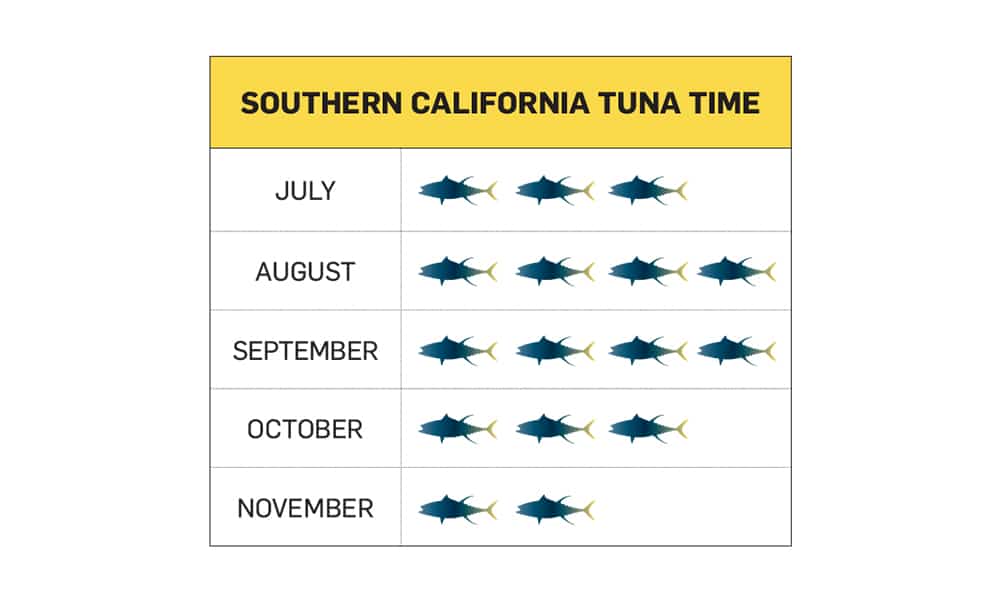
PaddyWhack
Kelp paddies attract a wide range of fish, including yellowfin tuna. Often the schools hang well below the kelp or swim in wide circles around it. It’s not necessary to fish right next to the paddy.
Slow-trolling live sardines in a wide circle around the outside of the paddy while tossing out one or two live chummers every 30 seconds sometimes brings tuna up from the depths. Stay 200 to 300 feet away from the paddy as you troll at a dead idle.
A popular practice is to stop close to the paddy, then chum with chunks of sardines and an occasional live bait and fish as you drift, as far as a mile away from the kelp. The idea is that the fish follow the chunk line to your baits.
This holds true when a deep school of tuna appears on the fish finder. Again, the idea is to chum them to the boat while fishing baits at a variety of depths, what local anglers call a “long soak.” Deploy a chunk or two every 15 to 30 seconds. Wait until one disappears before tossing out another.
During drifts, place baits at various depths in the water column. Often anglers will fish one or two live sardines with no weight (known as fly-lining), fish another mid-depth with a 1-ounce egg sinker held above the hook with a swivel, and place another bait deep with a 2- to 3-ounce egg sinker.
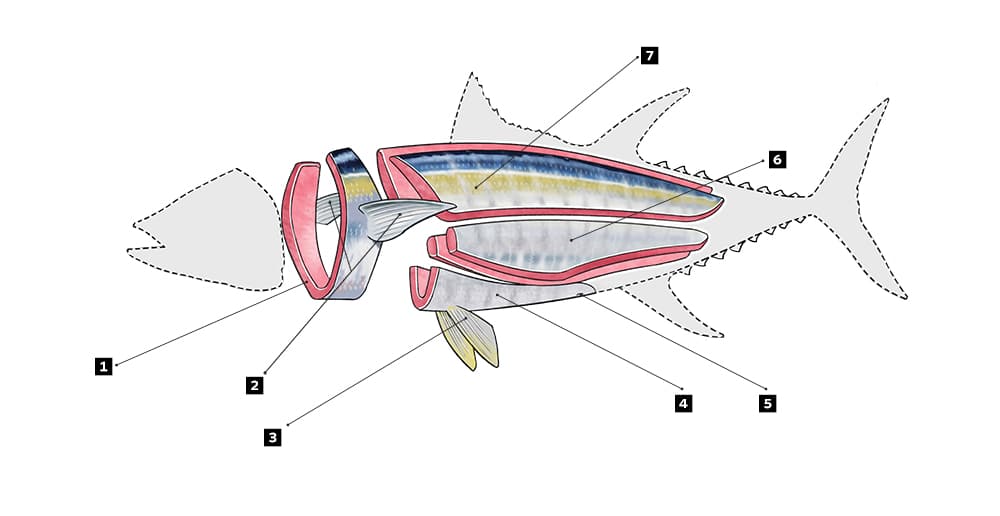
Chunk Bite
Don’t expect immediate results on long drifts. Expect to stick with it for 30 to 60 minutes before tuna respond to the chunk line. Once they rise from the depths, the fish have been known to ignore live bait in favor of a well-presented chunk bait, perhaps because they have become accustomed to slurping up fresh chunks and would rather not chase their meals. I’ve seen this on multiple occasions.
Read Next: Southern California Bluefin Tuna Fishing
When tuna don’t respond to liveys, cut a 1-inch section from the middle of a sardine, bury a 1/0 circle hook inside, and fly-line the chunk, feeding out line to keep it drifting naturally amid the chum.
If you complete a long drift with no results, don’t give up on your chunk line just yet. Slow-troll two or three live baits back to your starting point. Sometimes the tuna will be scattered along the chunk line, refusing to come to the boat. Slow-trolling a sardine back along your drift path sometimes does the trick.
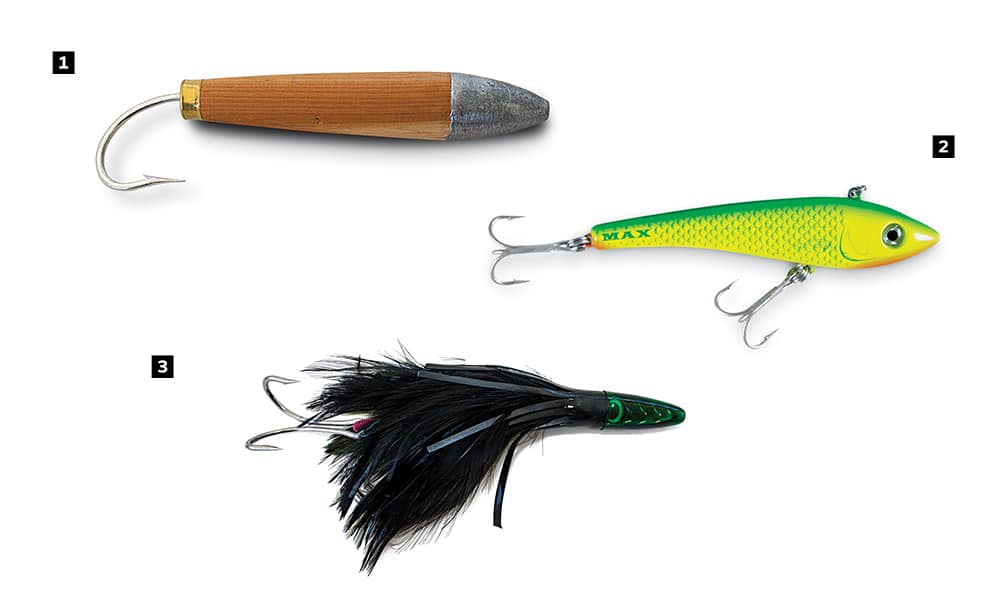
[2] Bibless divers such as the Halco Max130 make effective search lures when trolling.
[3] Dark trolling lures such as the Zuker Tuna Feather are most effective early in the morning. Salt Water Sportsman
SWS Planner: California Yellowfin Tuna
What: Yellowfin tuna Where: Southern California from the Channel Islands to Punta Banda, Mexico When: Late summer and early fall Who: Boating anglers with reliable craft from 22 feet up. A number of Southern California charters and guide services can show you the ropes. Here are three.
Pinnacle Sportfishing Capt. Duane Mellor 619-850-7575 pinnaclesportfishing.com
Season Sportfishing Capt. Jaime Thinnes 714-206-6146 seasonssportfishing.com
Bight Sportfishing Capt. Brandon Hayward 949-212-0719 bightsportfishing.com
SWS Tackle Box: California Yellowfin Tuna
Rods: 7- to 8-foot rated for 20- to 30-pound line Reels: Small- and medium-size conventional Line: 50- to 60-pound braid with a 100-foot fluoro top shot from 15- to 30-pound Terminal Rigs: Free-lining: size 1 to 3/0 Gamakatsu and Owner Mutu Hybrid circle hooks, matched to bait. Hook Pacific sardines crosswise through the nose or through the roof of the mouth. To fish deeper, add an egg sinker with swivel to hold it about 2 feet away from the hook.









